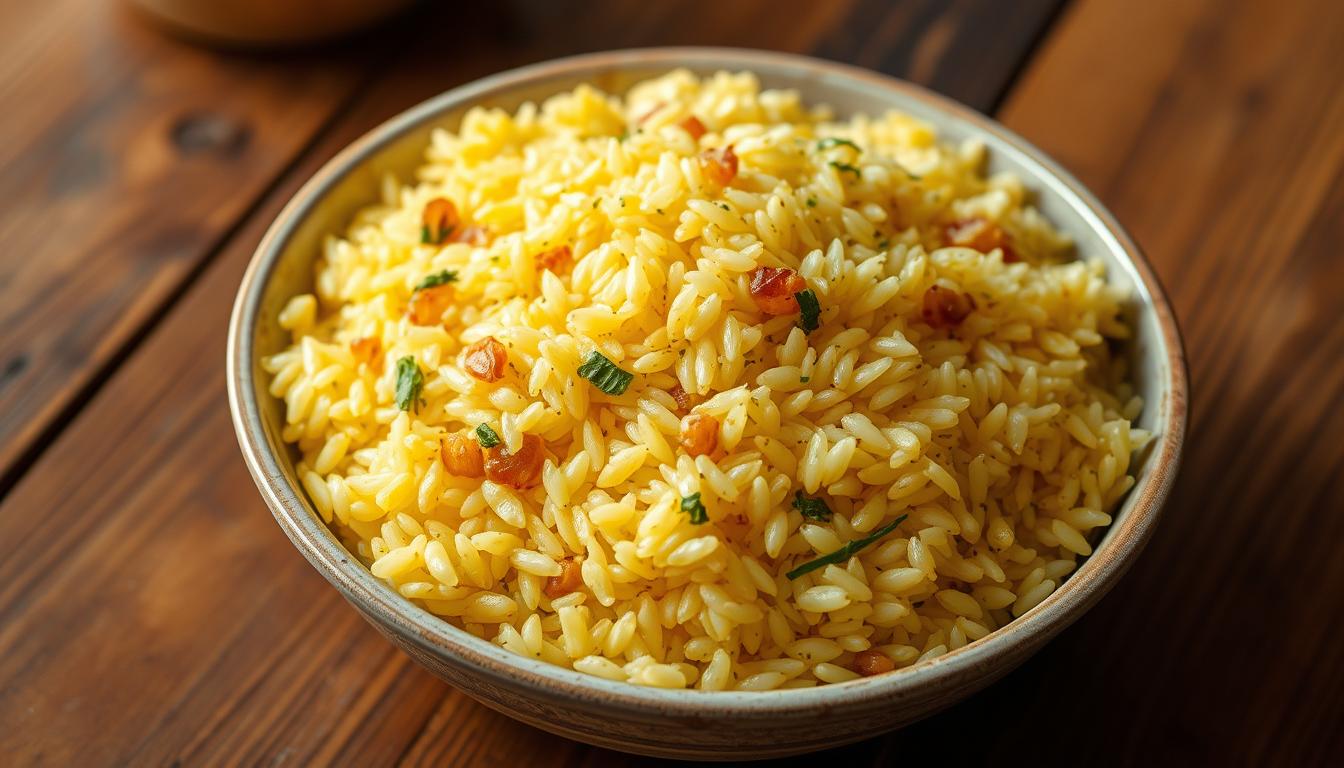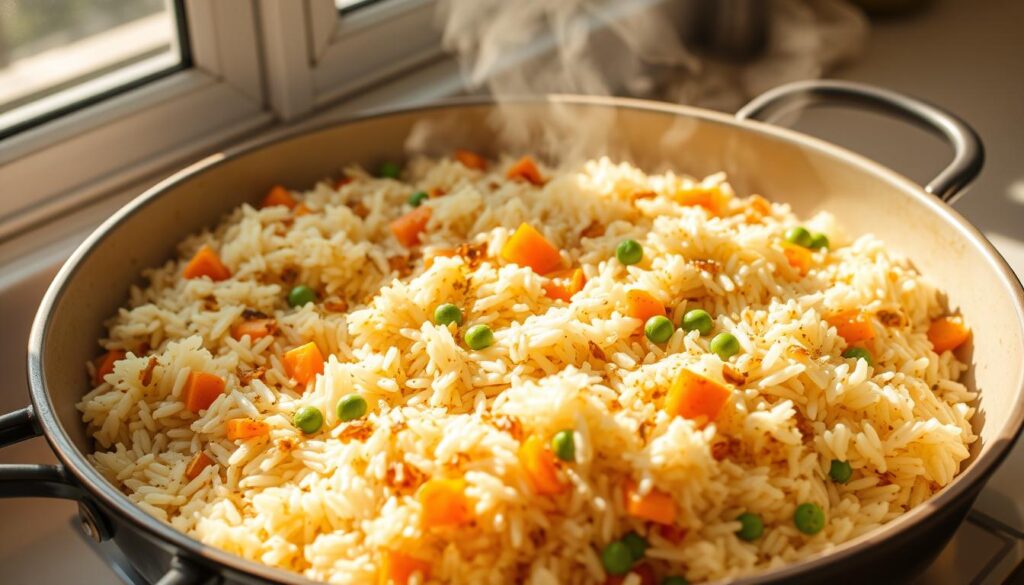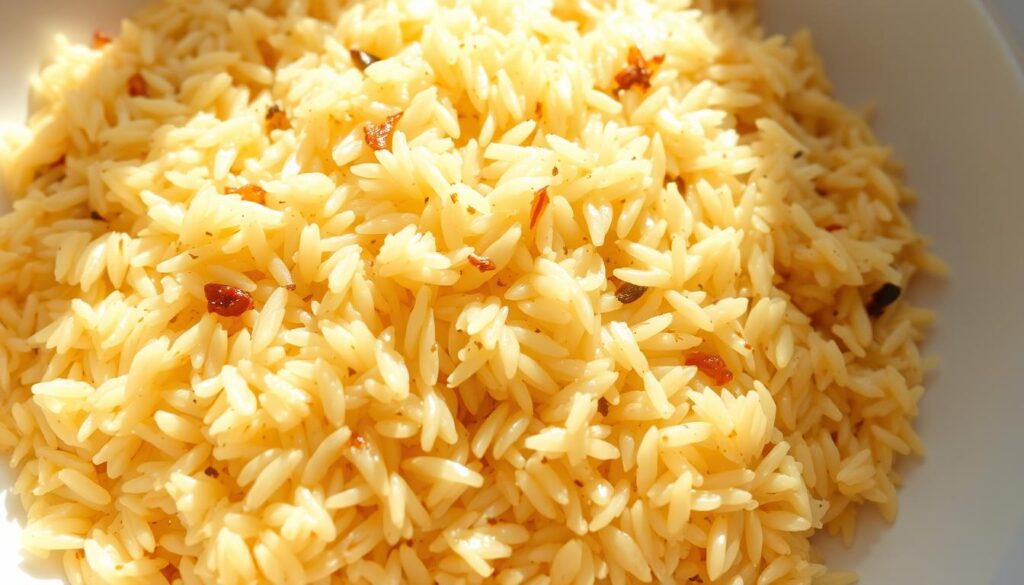is rice pilaf gluten free? You’re not alone. Finding safe, satisfying meals can feel like solving a puzzle. But what if your next comforting side dish was just a pot of rice away?
Rice pilaf starts with simple, gluten-free ingredients like long-grain rice, herbs, and broth. But cross-contamination in kitchens or added seasonings with wheat derivatives can change that. This guide breaks down what to watch for and how to make every bite safe and delicious.
Whether you’re cooking for a family dinner or a potluck, knowing how to prepare gluten-free rice pilaf opens doors to flavor without compromise. Let’s dive into the facts, so you can savor every grain worry-free.
Understanding Rice Pilaf
Rice pilaf is a dish made with toasted grains cooked in tasty liquids. It starts with sautéed onions and spices, which add flavor. Whether it’s a classic or gluten free rice pilaf, each grain absorbs the seasonings well.
What is Rice Pilaf?
This dish mixes toasted rice with veggies, herbs, and broth. First, rice is lightly fried in oil, giving it a nutty taste. Traditional recipes use butter or olive oil, but gluten free rice pilaf uses gluten-free alternatives.
Common Ingredients in Rice Pilaf
Every recipe has a few key ingredients:
- Rice (like basmati or jasmine)
- Vegetable or gluten free broth
- Onions, garlic, or leeks
- Oil or butter (make sure it’s gluten-free)
| Ingredient | Role |
|---|---|
| Onions | Base for flavor and sweetness |
| Cumin or turmeric | Adds earthy, aromatic notes |
| Vegetables | Carrots, peas, or bell peppers add texture and color |
Make your gluten free rice pilaf unique with herbs like parsley or chickpeas. Always check the ingredients to ensure they’re gluten-free.
Is Rice Gluten-Free?
Rice pilaf without gluten starts with a simple truth: rice itself contains no gluten. But cross-contamination in kitchens or added ingredients can complicate things. Let’s break down the facts to make your meal safe and delicious.
Defining Gluten and Gluten-Free
Gluten is a protein found in wheat, barley, and rye. Gluten-free means a food has less than 20 parts per million of these proteins. Rice naturally fits this standard, making it a core ingredient for rice pilaf without gluten. Always check labels for certifications like “gluten-free” to avoid hidden risks.
Gluten Content in Common Grains
- Wheat: Contains gluten, so avoid in gluten-free recipes.
- Buckwheat: Gluten-free, despite its name.
- Rice: Safe for all types—white, brown, or wild.
When making rice pilaf without gluten, opt for certified gluten-free grains and broths. Even small amounts of cross-contamination in kitchens or pre-made spices can pose dangers. Stick to fresh herbs and check seasoning labels for additives like malt vinegar (barley-based).
Popular Types of Rice Used in Pilaf
Choosing the right grain is key when making gluten free pilaf rice. These three types offer great texture and taste, all without gluten:
Long-Grain Rice
Long-grain rice has long, thin grains that stay separate when cooked. It’s light and fluffy, preventing clumps. Look for Lundberg Family Farms or Botanica for top quality.
Basmati Rice
Basmati rice has a nutty smell and long grains that grow when cooked. It’s a favorite in Middle Eastern and Indian dishes. Tilda and Kirkland Signature offer premium, gluten-free options.
Jasmine Rice
Jasmine rice smells sweet and floral, with a slightly sticky texture. It’s great for Southeast Asian pilafs, especially with coconut milk or lemongrass. Choose from Thailand’s Hom Mali or American Harvest for the best taste.
Each rice type brings something special to your gluten free pilaf. Try toasting the grains for extra flavor before adding herbs or broth. Always check the labels to ensure they’re gluten-free.
Preparing Gluten-Free Rice Pilaf
Learning to make rice pilaf celiac friendly begins with choosing the right ingredients. Follow these steps to keep your dish safe and tasty.
Selecting the Right Rice
Always pick rice that’s labeled “certified gluten-free” to avoid cross-contamination. Brands like Lundberg Family Farms and Basmati Gold are good choices. Rinse the rice well before cooking to get rid of any leftover bits.
Recommended Seasonings and Add-Ins
Boost flavor safely with these tips:
- Use fresh herbs (rosemary, thyme) or spices (paprika, cumin).
- Choose gluten-free vegetable broth from brands like Pacific Foods or Imagine Foods.
- Add sautéed veggies like carrots or peas for texture.
- Avoid pre-made seasoning packets unless they’re clearly labeled gluten-free.
Be careful with your ingredient pairings to keep your rice pilaf celiac friendly recipe intact. Always check the labels on oils and dairy to make sure they’re gluten-free.
Substituting Ingredients for Gluten-Free Pilaf
Changing recipes for rice pilaf gluten intolerance needs careful swaps. This guide shows how to replace common allergens. It ensures flavor and safety. Start by picking certified gluten-free alternatives for broths, proteins, and veggies.
Gluten-Free Broths and Stocks
Always pick broths that are “certified gluten-free” to avoid contamination. Stay away from brands that use equipment with wheat. Here are some good options:
| Brand | Type | Status |
|---|---|---|
| Swanson | Low-Sodium Chicken Broth | Certified GF |
| Pacific Foods | Organic Vegetable Broth | Certified GF |
| Imagine Foods | Plant-Based Broth | No gluten ingredients |
Vegetable and Protein Options
Pair rice with these safe ingredients for nutrition and taste:
- Vegetables: Bell peppers, spinach, or mushrooms
- Proteins: Boneless chicken, shrimp, or tempeh (check labels)
Make sure tofu or soy-based proteins are certified gluten-free. This is to avoid risks for those with rice pilaf gluten intolerance.
Health Benefits of Gluten-Free Rice Pilaf
For those with rice pilaf gluten sensitivity, this dish is more than safe—it’s packed with nutrients. It supports overall health and avoids allergens.
Nutritional Value of Rice
Rice is the main ingredient in pilaf, offering energy from complex carbs. A serving gives:
- ~205 calories
- 45g digestible carbohydrates
- Negligible fat and gluten
Adding whole grains increases fiber by 1-3g per cup. This helps with digestion and blood sugar.
Benefits of Whole Grains
Whole grains like brown rice increase nutrient intake. Here’s a comparison:
| Nutrient | Whole Grains | Refined Grains |
|---|---|---|
| Fiber | 3-4g per cup | Less than 1g |
| B Vitamins | Natural retention | Often enriched artificially |
| Minerals | Magnesium, iron preserved | Processed removal |
Choosing whole grains in your rice pilaf cuts down on empty calories. It also boosts heart and digestive health. For those with gluten sensitivity, it’s a way to get nourishment without giving up.
Storing Rice Pilaf
Proper storage keeps your gluten free rice dish fresh and tasty. Whether you’re prepping ahead or saving leftovers, follow these steps. They help keep the texture and flavor just right.
Best Practices for Storage
Put cooked rice pilaf in an airtight container to keep moisture in and odors out. Cool it down within two hours of cooking to stop bacteria from growing. For longer storage, freeze it in labeled bags or containers. Let it thaw in the fridge overnight before you reheat it.
- Refrigerate for up to 4 days.
- Freeze for up to 3 months.
- Use glass or BPA-free containers to retain quality.
Reheating Tips
Reheat small batches to warm everything evenly. For the microwave, cover with a damp paper towel to keep it moist. In the oven, spread it on a lined baking sheet at 300°F (150°C) until it’s warm. Stir it a few times.
Tip:Avoid overcooking reheated rice to prevent it from getting soggy. Taste and adjust the seasoning if needed.
By following these storage and reheating tips, your gluten free rice dish stays perfect. It’s great for meal prep or leftovers.
Gluten-Free Rice Pilaf Recipes
Make your kitchen a place of creativity with these gluten free rice recipes. Whether you want something simple or something with bold flavors, these recipes are perfect. They make sure your meals are safe and tasty.
Simple Rice Pilaf Recipe
Begin with this basic dish:
- 1 cup long-grain white rice
- 2 cups water or gluten-free broth
- 1 tbsp olive oil
- 1 small onion, diced
- Salt and pepper to taste
Steps:
- Rinse rice in cold water.
- Heat oil in a pot, sauté onions until translucent.
- Add rice, toast for 2 minutes.
- Pour in water, bring to a boil, then simmer covered for 18 minutes.
Flavorful Variations for Pilaf
Make your meal your own with these extras:
| Variation | Key Add-Ins | Flavor Profile |
|---|---|---|
| Herbed Pilaf | Parsley, dill, lemon zest | Fresh and aromatic |
| Citrus & Turmeric | Orange zest, turmeric, green onions | Zesty and warming |
| Spiced Nutty | Cumin, toasted almonds, paprika | Rich and nutty |
Try out these gluten free rice recipes to fit your meal’s theme. Change spices to your liking. Serve with grilled chicken or tofu for a complete meal.
Serving Suggestions for Rice Pilaf
Pairing your rice pilaf with the right dishes enhances its flavor and creates a balanced meal. Here are tips to make the best gluten free rice pilaf experience unforgettable.
Pairing with Main Dishes
- Grilled proteins like steak or salmon add richness. The rice’s mild taste complements bold marinades.
- Seafood dishes such as shrimp scampi or grilled calamari pair well with aromatic rice pilaf.
- Vegetarian options like roasted vegetables or lentil curries balance the starch with protein.
Creative Side Dish Ideas
Enhance your plate with these additions:
- Sprinkle with toasted nuts or seeds for crunch.
- Top with a drizzle of lemon or herb-infused olive oil.
- Serve alongside a fresh herb salad or roasted veggies.
Experiment with spices like cumin or turmeric to match main dishes. For a complete meal, combine rice pilaf with roasted chicken or a hearty stew. Remember, presentation matters—serve in bowls or on plates to highlight its texture and aroma.
Common Mistakes to Avoid
Learning to make gluten-free rice pilaf means knowing what not to do. These mistakes can mess up the texture or make it unsafe. Here’s how to avoid them.
Overcooking Your Rice
Cooking rice too long makes it soggy. Always follow the package instructions carefully. Check if it’s done 2 minutes before the time ends. Rice keeps absorbing heat even after the stove is off.
- Use a timer to track cooking phases.
- Drain excess water immediately to prevent softness.
Using the Wrong Ingredients
Gluten can hide in unexpected places. Always check the labels on broths, spice blends, and pre-mixed seasonings. Even butter or oils shared with wheat-based dishes can cause cross-contamination.
- Opt for certified gluten-free broth brands like Imagine Foods or Pacific Foods.
- Store gluten-free grains separately from wheat products.
“The top mistake? Skipping ingredient checks. Even ‘natural flavors’ can hide gluten,” warns the Cook’s Illustrated test kitchen.
Conclusion: Enjoying Gluten-Free Rice Pilaf
Rice pilaf is a great choice for those who follow gluten-free diets. It’s made with safe grains like basmati or jasmine rice. You can also make it your own by swapping ingredients.
This recipe is perfect for any meal, whether you’re cooking for yourself or guests. It’s both healthy and tasty.
Embracing Gluten-Free Alternatives
Choosing gluten-free rice pilaf lets you try new flavors without worrying about gluten. Make sure to use gluten-free broths and check the labels on spices. This way, you avoid hidden gluten.
Brands like Bob’s Red Mill and Arrowhead Mills have gluten-free rice and seasonings. Using high-quality ingredients makes your meal safe and enjoyable.
Celebrating Flavor and Variety
Adding saffron gives pilaf a beautiful golden color. You can also mix in peas or roasted vegetables for extra flavor. Try adding shrimp or tofu for a protein boost.
For a fresh twist, blend in herbs like cilantro. Serve it with roasted meats or as a base for grain bowls. Gluten-free eating doesn’t have to be dull.


